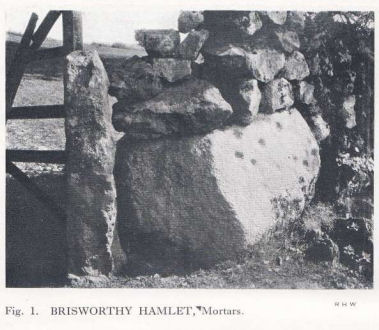
Brisworthy Cup Stone

R. H. Worth (1914) Stray Notes on Dartmoor Tin-working Fig. 8 and Fig. 9A.
Database entries
OS Map: SX 5598 6516
OS Source: Constructed
HER: MDV18859
Megalithic Portal: 45854
Alternate name: Brisworthy
Short Name: CS:Brisworthy
Butler map: 49.18
DPD page: 34
Exist: Yes
Record: Unique
Record Source: PDW
Hut Class: No
Lidar: SX 5598 6516
Guide Map: 47
Nearest Bus Stop: Meavy Primary School (3.2 km) [Route: 56]
Nearby sites: SX 5598 6516
Notes
HER: "Possible prehistoric cup-marked boulder of granite with at least 15 hollows, originally interpreted as a tinners' mortarstone in the early 20th century incorporated into a hedge/field boundary at Brisworthy."Butler and Greeves, suggest this is a cup-stone. Worth described it as a mortar stone unusually made of ordinary granite. It is worth quoting Worth at length:
Worth (1914): Northward from the last-described site a narrow, rough and watery lane leads to Brisworthy. On the eastern side at the extreme northern end of this lane where it opens out on the little hamlet are the remains of another blowing house, identified by the writer in 1911. A part of the wall remains in the face of the hedge, and a mortar stone is built into the hedge next to the southern gate-post of the field. The face of this stone measures 35 inches by 24 inches, and no less than fifteen mortar holes have been started in it. The largest has a diameter of 4 inches, and the smallest, of 2 1/4 inches only. The deepest is only sunk 1 1/8 inches into the stone (Fig 8). Such, a collection of mortar holes, all in an early stage of formation, is, to the writer, unknown elsewhere. A view of this stone is given (Fig. 9) and an elevation (Fig. 9a).
Worth (1940): [...] there remains one stone which is unlike anything found elsewhere. The mortars are usually formed in selected, fine-grained, granite or elvan, occasionally in quartz-schorl rock; but here an attempt has been made to utilise a boulder of ordinary granite, which has since been used to form one side of a gateway. The attempt met with no success; although sufficient perseverance was shown. There are on the face of this stone the beginnings of no less than fifteen mortars, the largest 4ins. in diameter and the smallest 2 1/2ins ; none has been carried to a greater depth than 1 1/8ins.
Butler (1994) p.134: Possibly contemporary with the circle is a cup-marked boulder set into the wall near the entrance to Brisworthy, a short distance to the south-west. Though common enough in other parts of the Highland Zone elsewhere in Britain, so far only three such blocks have been recognised on the Moor (TDA 1981). Some fifteen to eighteen small hollows forming no discernible pattern are exposed on the visible face of the stone.
Lethbridge photo and diagram p.34.
This photo by Worth appears reproduced in both the 1914 and 1940 articles.

References
These are selected references with an emphasis on out of copyright sources linked as PDFs. For more detailed references try any linked HER or PMD record above.
- Butler, Jeremy, Dartmoor Atlas of Antiquities, vol.3: The South-West, (1994)
- Greeves, T, Three prehistoric (?) cup-marked boulders on Dartmoor, D.A.S.P. No.39 pp.27-31 (1981)
- Lethbridge, William D., Discover Preshistoric Dartmoor, (2015)
- Worth, R. Hansford, Stray Notes on Dartmoor Tin-working, T.D.A. Vol.46 pp.284-289 (1914)
- Worth, R. Hansford, The Dartmoor Blowing House, T.D.A. Vol.72 pp.209-250 (1940)